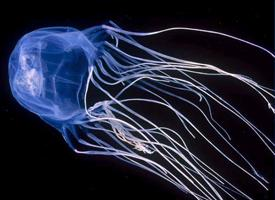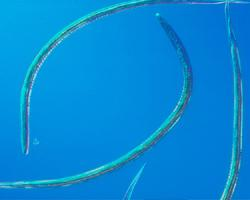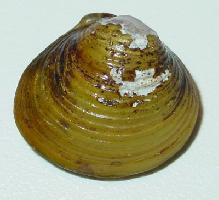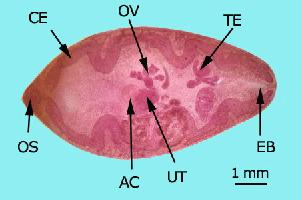
Popis zvířete
The Australian box jellyfish, scientifically known as Chironex fleckeri, is an aquatic marvel and one of the most fascinating yet formidable creatures inhabiting the waters of the Pacific Ocean, particularly around the northern coasts of Australia. This species stands out not only for its unique box-shaped bell but also for its reputation as one of the most venomous marine animals in the world, capable of delivering a sting that can be fatal to humans.Characterized by its transparent, pale blue body, the Australian box jellyfish can grow up to about 20 cm across the bell, with tentacles that can extend up to 3 meters in length. These tentacles are covered in cnidocytes, specialized cells that contain nematocysts – microscopic, venom-filled darts that the jellyfish uses for both defense and to capture its prey, which primarily consists of small fish and shrimp.
The bell's box-like shape is quite distinctive, with each of the four corners extending into clusters of up to 15 tentacles, giving the creature an almost otherworldly appearance. The design of its body is not just for show; it is highly functional, allowing the box jellyfish to propel itself forward at speeds of up to 6 kilometers per hour, making it one of the fastest swimmers among jellyfish species.
The venom of Chironex fleckeri is incredibly potent and is considered to be among the most deadly in the animal kingdom, containing toxins that attack the heart, nervous system, and skin cells. A sting from this jellyfish can cause excruciating pain, and in severe cases, can lead to cardiac arrest and death within minutes. Its venom's efficiency is such that it can quickly paralyze or kill its intended prey, allowing the jellyfish to feed with minimal effort.
Despite its fearsome reputation, the Australian box jellyfish plays a significant role in its ecosystem. It is a key predator that helps to maintain the balance of marine life in its habitat by controlling the populations of smaller fish and other creatures it preys upon.
The lifecycle of the Australian box jellyfish is quite fascinating, beginning as a sessile polyp that later transforms into a free-swimming medusa, the stage at which it is most recognizable and dangerous. These jellyfish are usually found in shallow waters near the coast, especially in mangrove swamps and estuaries, where they can pose a significant risk to swimmers and others enjoying the water.
Efforts to manage the dangers posed by Chironex fleckeri include the installation of jellyfish nets at popular beaches, the development of antivenoms, and public education campaigns to raise awareness about the risks of jellyfish stings and the importance of wearing protective clothing when swimming in affected areas.
Despite the peril associated with this remarkable creature, the Australian box jellyfish remains an object of intense scientific interest and fascination, a reminder of the incredible diversity and complexity of life forms on our planet and the intricate balance of ecosystems in the marine environment.
Podobná zvířata
Nové fotografie zvířat
Top 10 zvířat
- Chinese water dragon (Physignathus cocincinus)
- Galápagos tortoise (Geochelone nigra complex)
- Dolphin gull (Leucophaeus scoresbii)
- Japanese macaque (Macaca fuscata)
- Colombian red howler (Alouatta seniculus)
- Sea urchins (Echinoidea)
- Diana monkey (Cercopithecus diana)
- Moustached guenon (Cercopithecus cephus)
- Colossal squid (Mesonychoteuthis hamiltoni)
- Common house mosquito (Culex pipiens)


